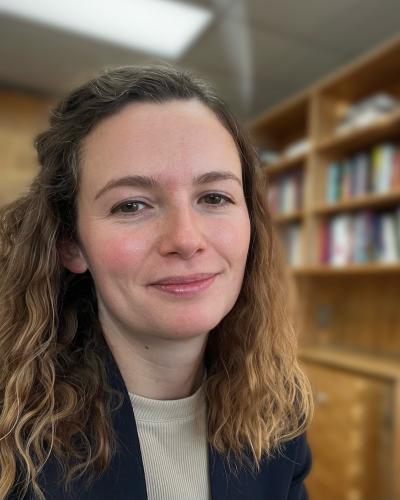Chloe Grace Hart’s research examines cultural beliefs about gender, romance, sexuality, and sexual violence in the United States. In one major stream of her research, she considers how cultural beliefs about sexual harassment create challenges for people who have experienced it. A second, emerging line of research examines how people believe romantic or sexual interest should be expressed. Methodologically, she toggles between in-depth interviews and survey experiments.
Recently, I had the chance to chat with Professor Hart to discuss her research, her research during her time as an undergrad Sociology major at Cornell, during her graduate work at Stanford, and beyond.
Did you know you wanted to study Sociology prior to choosing it as your major at Cornell as an undergrad? What initially drew you to the discipline?
I remember growing fascinated in middle school by how people sorted into social groups and hierarchies – who could sit with whom in the school cafeteria and so forth – and how that shaped the way others treated them. A few years later someone told me what sociology was, and I realized it was the tool I had been looking for to systematically understand the social dynamics I was observing. The rest is history.
What is something from your Cornell experience that stays with you? A favorite course? An inspiring professor? An interesting research project?
One defining experience was conducting my own research for my senior thesis. I had spent my sophomore year at Cornell in a sorority and then deactivated, and I left with very mixed feelings about the experience. I made lifelong friends in the sorority, but I was troubled by gender dynamics I encountered. Costume parties with themes like “CEOs and Secretary Hos” and “Golf Pros and Tiger’s Hos” – where fraternity men assumed roles of professionals and sorority women were invariably cast as sex objects – come to mind.
I became particularly interested in how the emphasis on sorority women’s position as sex objects in Greek life shaped the priorities of members of my sorority when it came time to recruit new members. When I was on campus, sororities derived status from the perceived physical attractiveness of their members, so some of my fellow sorority members became fixated on recruiting physically attractive women into our organization. Jarringly, during recruitment week when my sorority assessed potential new members, we often frankly referenced their physical attractiveness as a qualifying or disqualifying factor (“she’s cute” or “she’s busted” were common assessments).
In my senior thesis, I interviewed women across sororities about the extent to which physical attractiveness was discussed and prioritized during the recruitment process. My experience was not unique: women across sororities described a similar emphasis on the perceived attractiveness of potential new members when making recruitment decisions. The Greek life hierarchy created an incentive for us to value a quality that we wouldn’t have otherwise sought when building community and forming new friendships. It was a powerful lesson in how institutional structures can shape the values you act on.
Your research at Stanford focused on cultural beliefs about sexual violence in the United States, culminating in a dissertation about sexual harassment. What was and continues to be your motivation in pursuing this area of research?
When the concept of sexual harassment was explained to me as a young woman, I understood it to be a social problem that had been solved long ago – sort of like women abandoning corsets or gaining the right to vote. Then, working in various restaurants in my early 20s, I experienced sexual harassment several times myself, and I learned of friends with similar experiences. When I got to graduate school, I was really interested in investigating the forces through which this pervasive social problem had come to be minimized. How was it that I could have initially thought that sexual harassment didn’t happen anymore, when it turned out to be so widespread? Understanding the forces that promote a culture of silence around sexual harassment has been a driving research motivation for me. And when the MeToo movement unfolded while I was in graduate school, I became really interested in how the sudden visibility of sexual harassment as a social problem changed how people perceived it – for better and worse.
Your dissertation was titled “The Hidden Costs of Sexual Harassment.” What are some of the hidden costs of sexual harassment that you have documented in your research?
Sexual harassment is obviously a disempowering experience in the moment, but it creates challenges along a much longer timespan – before it occurs and well into its aftermath. In one interview-based project, I found that sexual harassment experiences often evolve from ambiguously sexual interactions (like weekend texts from the boss) to explicit sexual harassment (like being sexually propositioned by the boss). People with harassment experiences often come to recognize the early warning signs of sexual harassment and then try to shut down the possibility of harassment playing out: for example, by acting cold toward the person or avoiding events and meetings where the person will be present. These are very reasonable strategies, but they may interfere with career advancement: it’s hard to advance at work if you’re keeping a low profile and shutting out coworkers.
After someone has experienced sexual harassment, they have to contend with negative cultural stereotypes about people who say that they have been harassed – for example, the notion that people make up harassment allegations for attention or retribution, or that they are overreacting to normal behavior. In an experiment I conducted before the MeToo movement took off, this stigma translated into a career penalty: a woman who reported sexual harassment was seen as less worthy of a job promotion than an otherwise equivalent woman who did not report sexual harassment. Encouragingly, this effect faded away during the MeToo movement, but in more recent work, a collaborator and I have found that people who report sexual harassment are still seen as less warm and more attention-seeking and cutthroat – so, many of our negative stereotypes about targets of sexual harassment persist.
In a different experiment conducted in the wake of #MeToo, I found that people who come forward with sexual harassment allegations are particularly likely to be believed if they fit certain criteria. For example, people who respond assertively to the harassment in the moment and report the incident right away are more likely to be believed, even though in reality, most targets of sexual harassment do neither. Troublingly, I also found that people were more likely to believe a woman whose name was racially coded as white (Katelyn Walsh), rather than Black (Tanisha Washington), even when she was describing an otherwise identical harassment experience. Although the MeToo movement brought much-needed visibility to the issue of sexual harassment, these studies indicate that people who experience sexual harassment still face a host of challenges.
You have an emerging line of research that examines how people believe romantic or sexual interest should be expressed. Can you share a little bit about where you’re at with this research and if there any new directions or questions you’re especially excited to pursue?
Studying unwanted sexual advances for the last decade has made me realize how little we know about the strategies people think are appropriate to express initial romantic or sexual interest. Knowledge about how to express such interest isn’t formally taught – it’s not like you get a textbook about how to make romantic or sexual advances, growing up – so how do people learn it? And is everyone operating with the same unwritten rules, or are there different schools of thought about how advances should be made? Does this vary by gender, sexual orientation, or generation? I’m getting at these questions with a multi-method project that includes 100+ interviews with Wisconsin residents and a survey and survey experiment with a representative sample of Wisconsin residents.
One theme I’m particularly interested in is the ambiguity inherent in many romantic or sexual advances. Some of the most common ways that people initially express romantic or sexual interest include talking to a person, touching them on the arm or shoulder, or inviting them to do an activity one-on-one. However, these are things that people do with platonic intentions as well, so it can often be hard to parse whether an advance is being made. There are reasons that people rely on ambiguous strategies to express initial interest – for example, it avoids escalating sexually coded behavior in a way that could be perceived as harassing, and it makes romantic rejection less awkward when both parties can pretend it never happened. But the ambiguity also means that people may sometimes just fail to perceive one another’s advances – there’s a potential of missed connections through these ambiguous approaches.
What were your favorite spots around campus, when you were at Cornell?
The A.D. White Library and the Law Library for study days. The Cornell Botanic Gardens to get away from it all. And of course, every time I’m back in Ithaca, the first thing I do is hit up Collegetown Bagels for a rosemary salt bagel. I’ve never met a bagel I liked better than one from CTB.






